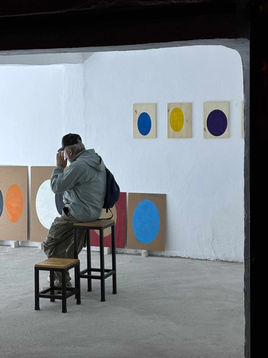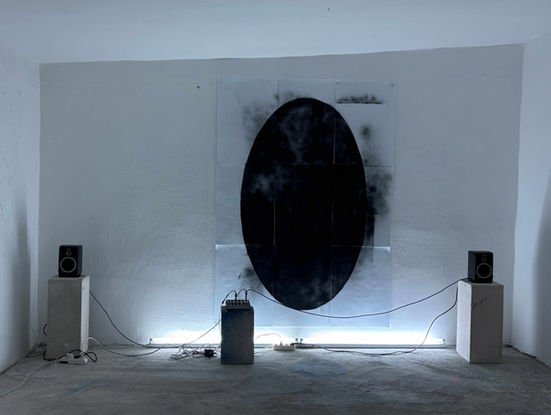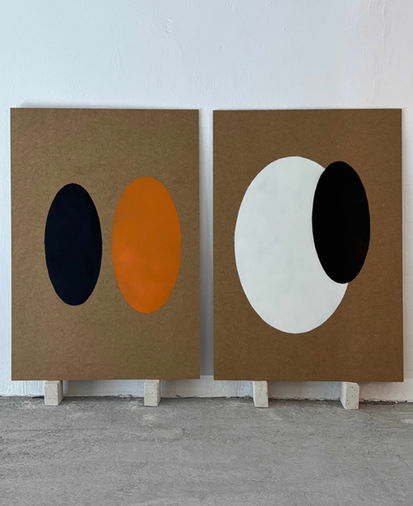elipse dair/about ellipse
Recently, when I used the ellipse as a formal reduction, I noticed that it had a quality that deeply affected me. Unlike the circle, which requires only a single center, the ellipse—with its two foci—could be formed in a highly variable way. This opened up a range that allowed for infinite diversity within reduction. It was as if the ellipse did not want to define itself in any fixed way. A circle remained a circle, but the ellipse was a state of transition, a threshold form, an attitude that resisted being fixed—and precisely for this reason it generated a certain uncertainty. More than that, it was a space that could be geometrically calculated and yet allowed for an infinite field of movement within. Inside an ellipse, imperfection and mobility could exist—within such a threshold space. For me, this was a new experience I wanted to pursue.
In the meantime, I invited the young music artist Gurur Gelen to collaborate,
because I felt that the result we achieved once again captured the sense of
collective wholeness that “garage” has always aimed for.
The ellipse is not a form of the absolute. Rather, it is an image of thought: flexible, non-linear, more complex. The ellipse is a form that moves between order and deviation. It carries the traces of the circle—the symbol of unity, perfection, transcendence—and at the same time resists it. Its two foci destabilize the center, multiply it, push it outward. They open order to fracture, create in-between spaces, activate memory, displacement, and polysemy.
In a world longing for uniformity, the ellipse carries another promise: the
promise of a complex coherence, of unresolvedness as a form of truth.
In this sense, the ellipse is not only a form—it is a space of thought. Here,
“perfection within imperfection” becomes not only visible but also tangible.
When the astronomer Kepler revealed that the planets move not in circles, as had
been assumed until then, but in elliptical orbits, the “error” of the circle
transformed into a beauty that is dynamic and alive. For him, the ellipse was
not a deviation from perfection but the proof of a deeper, more dynamic harmony
of the cosmos.
In music, this is heard as movements that do not gravitate toward a single tone or center, but oscillate between two foci—modulating harmonies or slightly destabilized rhythms. The ellipse is associated with non-linearity, imperfection, and suspension. Unlike the circle, which symbolizes completion, it represents instability and openness—qualities prominent in contemporary, jazz, or electroacoustic music. The ellipse refuses a center. It does not confine
music to a single point; it allows movement and openness, offering a listening experience beyond perfection and finality. In electronic music, the ellipse often functions to visualize phase
relationships, control stereo space, and sometimes as a metaphor for cyclical or
unstable motion. It operates as an aesthetic of deviation from perfection, the
fragile connections between phases, and a shifted sense of cyclical time.
--------------------------
Yakın zamanda biçimsel bir indirgeme olarak elipsi kullandığımda, onun beni etkileyen bir yönü olduğunu fark ettim. Yalnızca tek bir merkeze ihtiyaç duyan dairenin aksine, elipsin iki odağı olmasi nedeniyle, cok degisken bir şekilde olusturulabiliyordu. Bu durum, ifadenin indirgenmesinde sonsuz çeşitliliğe izin veren bir aralık açtı. Sanki elips kendini kesin biçimde tanımlamak istemiyordu. Bir daire daire olarak kalmaktaydi, ama elips bir geçiş durumu, bir eşik formu, sabitlenmeye direnen bir tutumdu – ve tam da bu nedenle belli bir belirsizlik
yaratmaktaydi. Daha çok, geometrik olarak hesaplanabilir ve içinde, yine de sonsuz bir hareket alanı tanıyan bir mekândı. Bir elipsin içinde, kusurluluk, hareketlilik, böylesi bir eşik alanında var olabiliyordu. Benim için bu, takip etmek istediğim yeni bir deneyimdi.
Bu arada genç müzik sanatçısı Gurur Gelen'i birlikte çalışmaya davet ettim. Çünkü aldığımız sonucun „garage“ in her zaman hedeflediği ortak bir bütünlüğü bir kez daha yakaladığını düsünüyorum.
Elips mutlak olanın bir formu değildir. Daha çok, düşüncenin bir imgesidir: esnek, doğrusal olmayan, daha karmaşık. Elips, düzen ile sapma arasında hareket eden bir formdur. Çemberin izlerini taşır – birlik, mükemmellik, aşkınlık sembolü – ve aynı anda ona karşı durur. İki odağı merkezi istikrarsızlaştırır, çoğullaştırır, dışa taşır. Düzeni kırılmaya açar, aradalık alanları oluşturur,
hafızayı, yerinden etmeyi, çok anlamlılığı harekete geçirir. Tekdüzeliğe özlem duyan bir dünyada elips, başka bir vaadi taşır: karmaşık bir tutarlılığın, çözülmemişliğin hakikat biçimi olarak vaadini.
Bu bağlamda elips yalnızca bir form değil – bir düşünce mekânıdır. ‘Kusurlulugun içindeki kusursuzluk’ burada yalnızca görünür değil, aynı zamanda deneyimlenebilir hâle gelir.
Gökbilimci Kepler'in, gezegenlerin o zamana kadar sanıldığı gibi dairesel değil, eliptik yörüngelerde hareket ettiğini ortaya koymasıyla, dairenin 'hatası' dinamik ve canlı bir güzelliğe dönüşmüştü. Elips, onun için mükemmellikten bir sapma değil, evrenin daha derin ve hareketli uyumunun bir kanıtıydı.
Müzikte elips, eksik veya kısaltılmış yapılarla gerilim yaratır. Besteciler tamamlanmamış cümleler ve beklenmedik kesintilerle dinlemeyi açık ve hareketli kılar. Elipsin hareketi kapalı ama merkezsizdir. Müzikte bu, ton veya merkeze yönelmeyen, iki odak arasında salınan hareketler olarak duyulur; modülasyonlu armoniler ve dengeden hafif çıkan ritimlerde görülebilir. Elips, doğrusal olmama, kusurluluk ve açıklık ile ilişkilidir. Daire gibi tamamlanmışlık yerine, istikrarsızlık ve açıklık simgesidir; çağdaş, caz veya elektroakustik müzikte öne çıkar. Elips merkezi reddeder. Müziği tek bir merkeze hapsetmez; hareket ve açıklık bırakır, mükemmellik ve kesinlik ötesi bir dinleme deneyimi sunar.
Elektronik müzikte elips, genellikle faz ilişkilerini görselleştirme, stereo alanı kontrol etme ve bazen de döngüsel/dengesiz hareketin metaforu olarak işlev görür. Elips elektronik müzikte mükemmellikten sapmanın estetiği, fazlar arasındaki kırılgan bağ ve döngüsel zamanın kaydırılmış hali olarak işlev görür.
Gurur Gelen
After studying sound engineering at SAE San Francisco, he earned a master’s
degree in Sonic Arts at ITU MIAM. He has produced cross-genre music, performed
live, and worked as an audio engineer internationally. In recent years, he has
focused on game development and coding as part of his artistic work.
Coşkun Demirok
was born in Ankara and has lived in Düsseldorf since 1971. From
1999 to 2017, he was one of the partners at the architectural firm “DGMArchitekten” in Krefeld. Alongside his work in architecture, he has consistently
maintained his identity as an artist. In recent years, having reconnected with
Ankara, he established the “garage” as his working space and, beyond that, as an
“artspace for experience.” More recently, his interests have expanded beyond the
visual arts to include text collages, photography, performance, installation,
and acoustic art.


soundscape "about ellipse" by
Gurur Gelen











